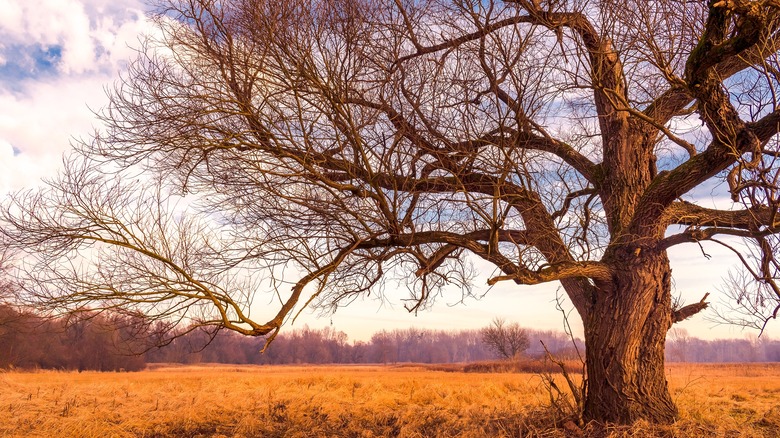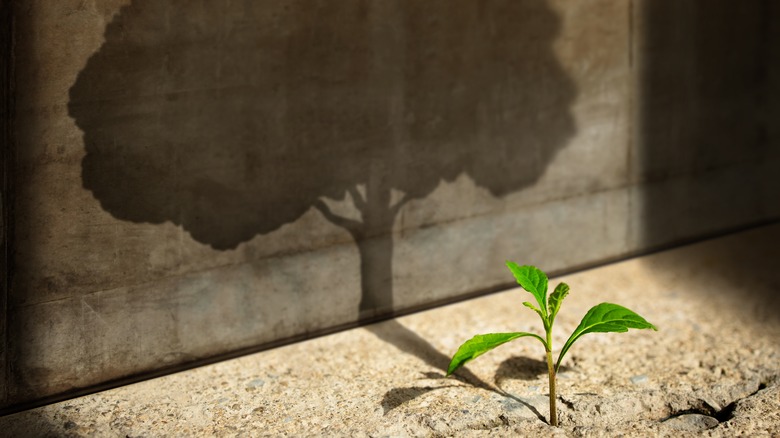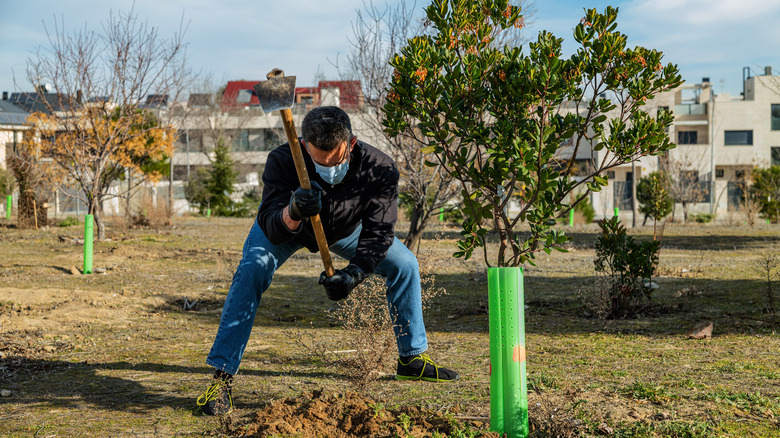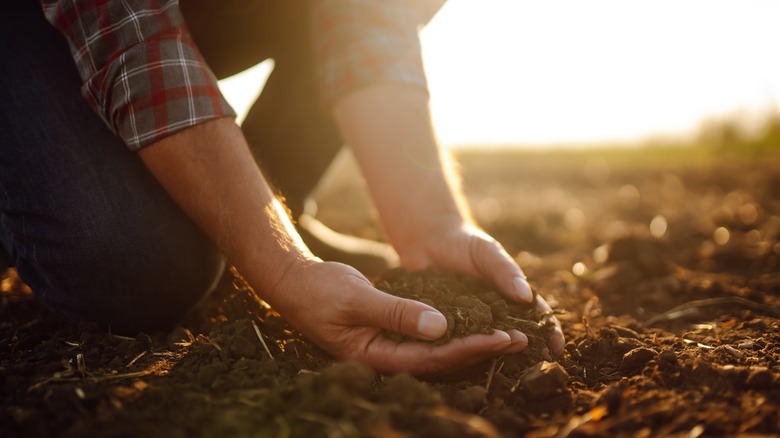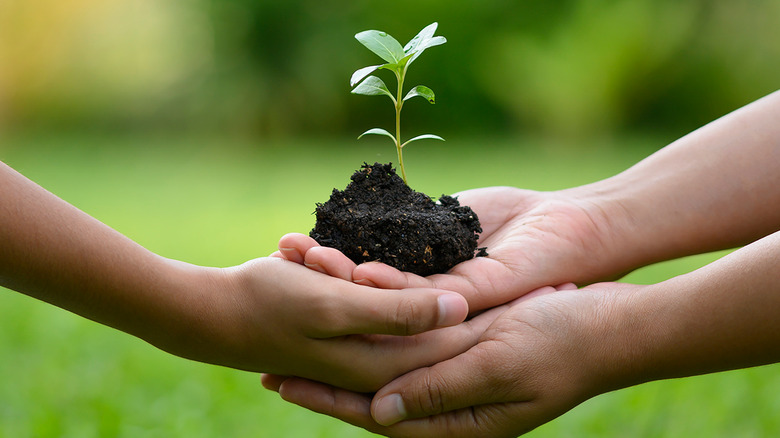5 Mistakes Everyone Makes When Planting A Tree
Planting new trees in the yard can be an immensely satisfying endeavor for homeowners. New growth looks great, and it makes for a much more scenic landscape from both the street view and out your windows into the yard from the interior of the home. Trees are an iconic part of any great landscaping effort, and planting new trees in the lawn is simply a must for just about anyone.
While planting a new tree has become easier than ever before with the explosion of nursery and garden store business sales and stocks in the last few years (with the industry worth $42.3 billion in 2022, according to IBISWorld), the availability of phenomenal tree varieties hasn't solved for the inherent pitfalls that can work their way into the planting effort of homeowners. Planting a new tree might seem like a straightforward process, but there are many things that can go wrong as you place your new arbor addition. From watering schedules to the physical process of sticking the plant into the ground in your yard, getting the installation right will help you avoid the potential need to start over again from scratch if the tree doesn't survive the planting.
Angi estimates that a medium-sized tree will typically cost around $255, so ensuring that your new tree gets exactly what it needs to thrive in your lawn will make for both a beautiful addition to the home and a means of keeping landscaping costs low.
1. Planting in the wrong season
Trees purchased from a nursery will already have a year or more of growth. These plants have been carefully cultivated in the nursery to provide a healthy specimen capable of surviving the shock of transplant. Nursery plants have been pruned, watered, and provided with the necessary sunlight and other growing conditions that will develop strong roots and a healthy trunk. But all this goes out the window if you plant it in the ground during the wrong season. The Irish Agriculture and Food Development Authority reports that the best time of year to plant a new tree is between November and March. The coldest months of the year will provide the new plant with the perfect growing conditions to establish itself in the new location. This might sound counterintuitive, but the truth is that plants go through a yearly cycle of continuous growth, and the winter months see a specific type of movement in the plant that often goes unnoticed.
During the spring and summer, trees burst into life and produce a flurry of new aerial growth. This time of year, the tree's energy is focused on creating as much leafy green coverage as possible to soak up the sunlight and create the glucose sugars that feed the entire plant.
The winter months see extensive root development, meaning a new planting during this time will allow the roots to establish in their new home. Without this dormant time, a plant may not survive long-term.
2. Digging a hole that's the wrong size
In addition to seasonal issues, a tree cannot thrive in its new location if it doesn't have the right amount of space to branch out and establish its root system in the environment that will remain its home. A small hole won't provide the loose soil required to give the roots the start they need to continue growing into the space. Similarly, a hole that's too big won't provide the stability that the tree's aerial growth needs to maintain a steady, upright posture. The Iowa State University Extension reports that the hole you dig should be two to three times wider than the root ball on the tree. The hole should be sloped inward so that the bottom of the planting space is narrower than the top, where the trunk will extend upward from.
Similarly, the Iowa State University team notes that in well-draining soil, planting holes should be 2 or 3 inches shorter than the height of the root ball, but in poorly drained soils, this should be extended to a measure of about two-thirds of the height. This means that in soils that don't drain well, the root ball should be planted higher up out of the ground than in soils that do. This step will ensure that the roots aren't sitting in stagnant water, potentially leading to rot that would kill the tree from the ground up.
3. Fertilizing the newly planted tree too early
It might be tempting to fertilize a new tree once you've finished digging the hole and adding the new plant to the lawn. Fertilizers are a natural follow-up step for many people. But the addition of fertilizer at this stage can eventually (or perhaps even quickly) kill your new tree. The University of Maryland Extension reports that fertilizer is a key resource for nutrient-deficient landscapes and soils, and their addition can make for a long-lasting tree. Yet, fertilizers often stifle root growth in an effort to promote expanded aerial growth. In the first year or two of your tree's ongoing development, root growth will be the primary focus of the plant. Building a strong network of underground roots will help the tree soak up moisture and maintain a strong foothold in the ground itself. Without this network beneath the tree, it won't be able to grow to its full potential and may even simply keel over once the above-ground growth outpaces the subterranean sections.
Laying off the fertilizer for a year or two after the new tree has been planted will give it the time it needs to establish itself in your lawn. Likewise, adding fertilizer to the grass or other plants around the tree should be avoided, too. This will prevent unwanted absorption through adjacent plant matter.
4. Placing the tree in the wrong area
A tree isn't like other elements of the yard. These plants live for decades or even centuries when well cared for, and they grow quickly into a significant visual and physical feature of the lawn. Trees become massive in a hurry and therefore are immovable objects in the lawn and anywhere else they are planted. Selecting the perfect spot for your new tree is crucial before even digging the hole. Tree area selection is made up of a few key decisions (via Level Green Landscaping). Primarily, you'll want to consider how tall the tree will grow. The Arbor Day Foundation notes that plum trees often grow to a mature height of around 20 feet, while a red oak or walnut tree can grow to 80 feet. Placing a tree right next to your home's structure or foundation can be a problem if that plant will grow to eclipse the property. The root growth beneath the soil alone can threaten the structural integrity of the home in this circumstance.
Placing trees in partial or full sunlight, maintaining spacing requirements that will support healthy growth to full heights for all your new additions, and more are crucial considerations to make in this early phase of tree growth. You can't move these plants later, so getting their positioning right at this point in the process is essential.
5. Underwatering the new addition
It's obvious that a new tree will need to be watered. Moisture is a key ingredient in healthy plant growth across type and species considerations, from cactus varieties that require minuscule amounts of water to mosses that thrive in the dampest of conditions. Watering for the first few days after planting is a given. However, a new tree will need consistent moisture addition that's different from established trees for a few years, not just a few weeks, according to the University of Minnesota Extension. It can take two or three years for a newly planted tree to fully establish its root system, and until this happens, you'll need to water the area surrounding the tree more frequently than other plants in your yard.
For the first two weeks after planting, you'll need to water the tree every day and then every two to three days for the next three months. After passing this key phase in the tree's development, watering once per week until the root system has established will ensure that the plant has all the resources it needs to grow into a strong and long-lasting staple in your lawn. The University of Minnesota Extension notes that a measurement of the trunk diameter at 6 inches above the ground can help you establish a timeline. For instance, a 3-inch reading signals a rooting timeline of four and a half years and a weekly watering volume of 3 to 4 ½ gallons.
